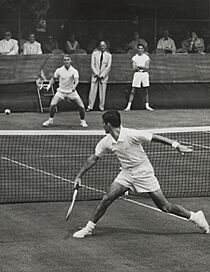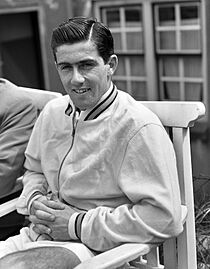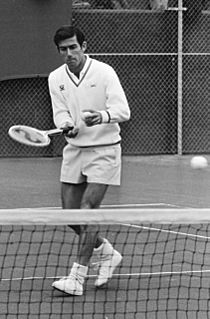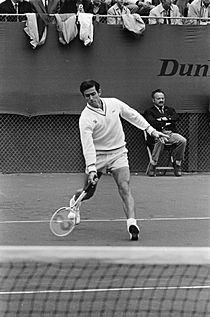Ken Rosewall facts for kids
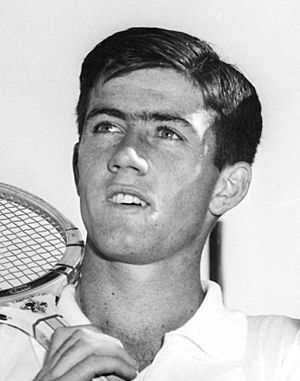
Rosewall in the mid-1950s
|
|
| Full name | Kenneth Robert Rosewall |
|---|---|
| Country (sports) | |
| Residence | Sydney, New South Wales, Australia |
| Born | 2 November 1934 Sydney, New South Wales, Australia |
| Height | 1.70 m (5 ft 7 in) |
| Turned pro | 1956 (amateur since 1950) |
| Retired | 1980 |
| Plays | Right-handed (one-handed backhand) |
| Prize money | US$1,602,700 |
| Int. Tennis HoF | 1980 (member page) |
| Singles | |
| Career record | 1811–710 (71.84%) |
| Career titles | 147 (40 listed by the ATP) |
| Highest ranking | No. 1 (1961, L'Équipe) |
| Grand Slam singles results | |
| Australian Open | W (1953, 1955, 1971, 1972) |
| French Open | W (1953, 1968) |
| Wimbledon | F (1954, 1956, 1970, 1974) |
| US Open | W (1956, 1970) |
| Other tournaments | |
| Tour Finals | RR – 3rd (1970) |
| WCT Finals | W (1971, 1972) |
| Professional majors | |
| US Pro | W (1963, 1965) |
| Wembley Pro | W (1957, 1960, 1961, 1962, 1963) |
| French Pro | W (1958, 1960, 1961, 1962, 1963, 1964, 1965, 1966) |
| Other pro events | |
| TOC | F (1958FH) |
| Doubles | |
| Career record | 211–113 (Open Era) |
| Career titles | 14 listed by the ATP |
| Grand Slam doubles results | |
| Australian Open | W (1953, 1956, 1972) |
| French Open | W (1953, 1968) |
| Wimbledon | W (1953, 1956) |
| US Open | W (1956, 1969) |
| Mixed doubles | |
| Career record | 21–6 |
| Career titles | 1 |
| Grand Slam mixed doubles results | |
| French Open | SF (1953) |
| Wimbledon | F (1954) |
| US Open | W (1956) |
| Team competitions | |
| Davis Cup | W (1953, 1955, 1956, 1973) |
Kenneth Robert Rosewall (born November 2, 1934) is an Australian former world No. 1 professional tennis player. He won many titles throughout his long career. Ken Rosewall won 147 singles titles, including 23 major championships. These include 15 "Pro Majors" (important professional tournaments before the Open Era) and eight "Grand Slam" tournaments. He also won many doubles titles.
Rosewall was known for his amazing backhand shot. He played at the highest level of tennis from the early 1950s to the early 1970s. Many experts ranked him as the world's best male tennis player from 1961 to 1964, and again in 1970, 1971, and 1972. He was first ranked in the top 20 players in 1952 and stayed there until 1977.
Even though he was naturally left-handed, his father taught him to play tennis with his right hand. He was not very tall, about 5 feet 7 inches (1.70 m), and weighed around 148 pounds (67 kg). Other players jokingly called him "Muscles" because he wasn't very big. However, he was incredibly fast, agile, and never seemed to get tired. He was also excellent at hitting the ball close to the net, called a volley. Ken Rosewall is a father of two and a grandfather of five. He lives in northern Sydney, Australia.
Contents
Ken Rosewall's Early Life and Tennis Beginnings
Ken Rosewall was born in Hurstville, Sydney, on November 2, 1934. His father, Robert Rosewall, owned a grocery store. When Ken was one year old, his family moved to Rockdale. There, his father bought three clay tennis courts.
Ken started playing tennis at just three years old. He used a shorter racket and hit the ball with both hands for both forehand and backhand shots. He and his father practiced early in the morning, focusing on one type of shot for weeks. Even though he was naturally left-handed, his father taught him to play right-handed.
Ken played his first tournament when he was nine years old. He lost to the player who eventually won the tournament. When he was eleven, Rosewall won the Metropolitan Hardcourt Championships for players under fourteen.
Playing Against Lew Hoad
In his younger years, Rosewall often played against Lew Hoad. They were known as the "Sydney twins" because they were both talented young players. However, they looked different and had very different playing styles. Their first match was in Sydney in January 1947, when they were both 12. Rosewall won easily. He continued to beat Hoad in other matches that year. Rosewall's steady playing style often helped him win against Hoad's more aggressive shots. In 1949, at age 14, Rosewall became the youngest player to win an Australian junior title.
Ken Rosewall's Tennis Career
Amateur Years: 1950 to 1956
- 1950
In September 1950, at 15, Rosewall reached the final of a hard court championship but lost. In October, he made it to the semifinals of another championship, where he was defeated by a top adult player, Ken McGregor.
- 1951
Rosewall won his first men's tournament in Manly, New South Wales, in January. He was the youngest player ever to win that title. He played almost perfectly, especially with his ground shots and volleys. His only weak spot was his smash shot. Later that year, he played against Dick Savitt, who was the Australian and Wimbledon champion, and pushed him to four sets.
- 1952
In 1952, at just 17, Rosewall reached the quarterfinals of the U.S. Championships. He surprised everyone by beating the top-seeded player, Vic Seixas. At the end of the year, experts ranked Rosewall and his doubles partner, Lew Hoad, as the tenth best amateur players in the world.
- 1953
Rosewall was only 18 when he won his first major singles title in 1953 at the Australian Championships. He then won the French Championships, showing great skill. He was the top player at Wimbledon but lost in the quarterfinals. He also reached the semifinals at the U.S. Championships.
Rosewall helped Australia win the Davis Cup in 1953. He won 15 of the 17 singles matches he played in the Davis Cup during his amateur years.
- 1954
In 1954, Rosewall reached the Wimbledon final but lost to Jaroslav Drobný. He continued to win other tournaments, showing his strong game.
- 1955
Rosewall won the Australian Championships for the second time in 1955, beating Hoad in the final. He did not play in the French Championships that year. He reached the semifinals at Wimbledon and the final at the U.S. Championships.
- 1956
In 1956, Rosewall and Hoad, known as "The Gold Dust Twins", won almost all the Grand Slam men's doubles titles. In singles, Rosewall lost to Hoad in the finals of the Australian Championships and Wimbledon. However, Rosewall stopped Hoad from winning all four Grand Slams by beating him in the U.S. Championships final. Rosewall's excellent backhand and clever shots helped him win.
Experts ranked Rosewall as the world's No. 2 player behind Hoad for 1956.
Professional Career: 1957 to 1968
In late 1956, Rosewall decided to become a professional tennis player. This meant he could earn money from playing, but he couldn't play in the major amateur tournaments like the Grand Slams for a while.
- 1957
Rosewall played his first professional match on January 14, 1957, against Pancho Gonzales, who was the top professional player. Gonzales won their first series of matches. Rosewall later explained that there was a big difference between amateur and professional tennis.
In September, Rosewall won the Wembley Pro title, which was a big win for him. By the end of the year, he was doing very well in professional tennis.
- 1958
Rosewall continued to do well in professional tournaments. He was the runner-up at the Forest Hills Tournament of Champions. He also won the French Professional Championships, showing he was still one of the best players on clay.
- 1959
Rosewall started to have a better record against Pancho Gonzales in 1959. He won two tournaments in Brisbane. He finished third in a major professional series, showing he was one of the top three professional players.
- 1960
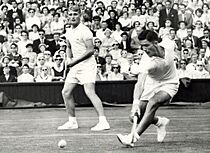
Rosewall was part of a new World Pro tour. He finished second behind Gonzales on this tour. He won six tournaments in 1960, including the French Pro and Wembley Pro titles.
- 1961
After many years of touring, Rosewall took a break to spend time with his family. He returned to play in the summer and won the two biggest tournaments: the French Pro (on clay) and Wembley Pro (on wood). He beat Gonzales in the French Pro final and Hoad in the Wembley final.
Experts started to rank Rosewall as the new No. 1 player in the world.
- 1962
In 1962, Rosewall was the top professional player, winning most of the tournaments. He successfully defended his Wembley Pro and French Pro titles. He was ranked as the world No. 1 professional player by several sources.
- 1963
Rosewall had an amazing year in 1963. He beat Rod Laver in many matches. He won the three main professional tournaments of the year: the U.S. Pro, the French Pro, and the Wembley Pro. This achievement is known as a "Pro Slam." He was voted the world's number one professional player.
- 1964
In 1964, Rosewall won the French Pro tournament again. He was officially ranked as the No. 1 professional player, ahead of Laver and Gonzales. Even Laver himself said that Rosewall was still the No. 1 player, despite Laver winning some big tournaments that year.
- 1965
Rosewall continued his strong performance. He won the U.S. Pro tournament and the French Pro final, both against Rod Laver.
- 1966
Laver and Rosewall were the dominant players in 1966, sharing all the major titles. Rosewall won the Madison Square Garden Pro and the French Pro tournaments.
- 1967
In 1967, Laver won more tournaments than Rosewall. However, Rosewall still won six titles that year. During his professional career from 1957 to 1968, Rosewall won at least 62 tournaments.
Open Era Career: 1968 to 1980
The "Open Era" of tennis began in April 1968. This meant that professional players could now compete in the Grand Slam tournaments alongside amateur players.
- 1968
Rosewall, at 33 years old, won the first "open" tennis title at Bournemouth. He then won the French Open, which was the first Grand Slam tournament of the Open Era. This showed he was still the best clay court player. He also reached the final of the Pacific Southwest Open and won the Wembley Pro tournament. At 34, he was ranked No. 2 or No. 3 in the world.
- 1969
Rosewall was no longer the top clay court player, as Laver beat him in the French Open final. He lost earlier than expected at Wimbledon and the US Open. He won three smaller tournaments that year.
- 1970
Rosewall did not play the Australian Open or the French Open in 1970 due to disagreements over prize money. However, he reached the final of Wimbledon, losing a close five-set match to John Newcombe. Two months later, at the U.S. Open, Rosewall won his sixth Grand Slam title, beating Newcombe and then Tony Roche in the final.
Rosewall had a great year in 1970. He was very close to winning both Wimbledon and the U.S. Open. Many experts ranked him as the world No. 1 that year.
- 1971
Rosewall continued his excellent form in 1971. He won the Australian Open without losing a single set. This was his second Grand Slam win in a row and his seventh overall. He beat Arthur Ashe in the final.
He did not play the French Open. At Wimbledon, he reached the semifinals but lost to Newcombe. He also missed the US Open due to a conflict between tennis organizations and because his sons were ill.
Rosewall won the WCT Finals, beating Laver in a thrilling four-set final. This match was considered one of the best between the two rivals.
- 1972
In 1972, Rosewall won his fourth Australian Open title, and his eighth and final Grand Slam title. At 37 years and 2 months old, he became the oldest male player to win a Grand Slam singles title in the Open Era.
The final of the WCT Finals between Rosewall and Laver was a huge event. It was watched by 23 million people in the U.S. and is known as the "match that made tennis in the United States." Rosewall won this epic five-set match, which was his last major title.
- 1973
Rosewall had an early exit at the 1973 Australian Open. He did not play Wimbledon that year because many players boycotted the event. However, he returned to play in the Davis Cup after 17 years.
His best results in 1973 were reaching the semifinals of the US Open and finishing third at the WCT Finals. He was still ranked in the top 10 players in the world.
- 1974
In 1974, Rosewall reached two Grand Slam finals: Wimbledon and the US Open. At Wimbledon, at 39 years old, he had an incredible comeback in the semifinals to reach the final. However, he lost to Jimmy Connors. He was still ranked among the top players in the world.
- 1975–1982
Rosewall remained in the top 10 in 1975, winning five tournaments. He made his last attempt at Wimbledon at over 40 years old. In 1976, he won three more tournaments.
In 1977, at 43, Rosewall reached the semifinals of the Australian Open. He won his last two titles in Hong Kong and Tokyo. He even beat the world No. 3 player, Vitas Gerulaitis, in a semifinal match. He gradually retired from the sport. In 1980, at nearly 46, he won a match against a top-50 player before losing. He made a brief comeback in 1982 at 47, reaching a final in a smaller tournament.
By 1972, Rosewall was the second tennis professional to earn over $1 million in prize money.
Ken Rosewall's Rivalries
Ken Rosewall had famous rivalries with Pancho Gonzales and Rod Laver. His matches with Laver are very well known.
Laver generally had a better record against Rosewall in the Open Era. Overall, Laver won more matches against Rosewall.
Rosewall and Gonzales played over 200 matches as professionals. Gonzales won more of these matches.
Ken Rosewall's Playing Style and Legacy
When Ken Rosewall first became a professional, he mostly played from the back of the court. But he quickly learned to play well at the net, which helped him stay a top player for many years. His sliced backhand shot was incredibly strong and is considered one of the best in tennis history. He also had an excellent first volley.
Many people consider Ken Rosewall to be one of the greatest tennis players of all time. He was known for staying healthy and avoiding injuries, which allowed him to win tournaments even at 43 years old.
Although he reached the final of Wimbledon four times, he never won the title. He was also a finalist at the 1974 US Open at 39 years old, making him the oldest player to reach two Grand Slam finals in the same year. In 1972, he became the oldest male player to win a Grand Slam singles title in the Open Era, at 37 years and 2 months old.
In 1995, Pancho Gonzales said that Rosewall became a more complete player as he got older. He said Rosewall could handle almost any opponent.
In a 2012 ranking of the "100 Greatest of All Time" tennis players, Rosewall was ranked number 13 among male players. Only two other Australian players, Laver and Emerson, were ranked higher.
Ken Rosewall's Personal Life
Ken Rosewall married Wilma McIver, who was also a tennis player, on October 6, 1956. Their wedding was a big event in Brisbane. They had two sons and lived in Sydney. Wilma passed away on April 27, 2020.
Ken Rosewall's Honours and Recognition
In 1971, Ken Rosewall was appointed a Member of the Order of the British Empire (MBE). In 1979, he was appointed a Member of the Order of Australia (AM).
Rosewall was inducted into the International Tennis Hall of Fame in 1980. In 1985, he was inducted into the Sport Australia Hall of Fame. He is also recognized as an Australian Living Treasure.
To honor his contributions to tennis, the main court at the Sydney Olympic Park Tennis Centre was renamed the Ken Rosewall Arena in 2008.
In 2023, Rosewall was invited to present the Men's Singles trophy at the Australian Open Championship. This was to celebrate the 70th anniversary of his first Australian singles championship victory.
Images for kids
See also
 In Spanish: Ken Rosewall para niños
In Spanish: Ken Rosewall para niños


